UPSC GS 1
Kharchi Puja
- News: The Prime Minister Shri Narendra Modi recently wished the people of Tripura, on the occasion of Kharchi Puja.
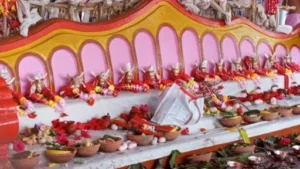
- Definition:
-
- Kharchi Puja, also known as the Festival of 14 Gods, is a century-old auspicious festival celebrated every year by the people of Tripura.
-
- Key Deity:
-
- People worship Chaturdasa Devata, the ancestral deity of the Tripuri people.
-
- Month:
-
- This festival falls on the eighth day of the new moon in July or August and lasts for a week.
- The festival is observed annually on Shukla Ashtami, which is the eighth day of the lunar month of Ashadha.
-
- Key Rituals:
- Carrying and Dipping Idols:
-
- The royal priests perform the revered ritual of carrying the idols of the Fourteen Gods from the ancient Ujjayanta Palace in Agartala.
- They then dip the idols in the holy water of the Saidra river.
- After this purification ritual, the idols are taken back to the temple.
-
- Decoration of Idols:
-
- Upon returning to the temple, the idols are adorned with different flowers, traditional attires, ornaments, and vermillion paste.
-
- Construction of Chaturdasha Mandapa:
-
- One of the notable rituals is the construction of the Chaturdasha Mandapa, which symbolizes the royal palace of the Tripuri kings.
- This structure is built by traditional artisans using bamboo and thatched roofs.
-
Read also: Recent Significance of India-Austria Relations | UPSC
Mahabodhi Temple Complex
- News: A geospatial analysis utilising satellite images and ground surveys has found evidence of the presence of “huge architectural wealth” buried in the Mahabodhi temple complex.
- Overview:
-
- The Mahabodhi Temple Complex is one of the four holy sites associated with the life of Lord Buddha, marking the spot of his Enlightenment (Bodhi).
- Located in Bodh Gaya, central Bihar, on the banks of the Niranjana River, it stands as one of the few surviving examples of early brick structures in India.
-
- History:
-
- First Temple: Built by Emperor Asoka in the 3rd century B.C.
- Present Temple: Dates from the 5th or 6th centuries, built entirely in brick, and is a significant example of late Gupta period architecture.
- UNESCO World Heritage Site: Recognized in 2002.
-
- Architectural Significance
-
- Brick Architecture: One of the earliest Buddhist temples built entirely in brick, influencing brick architecture development over centuries.
- Stone Balustrades: Early example of sculptural reliefs in stone.
-
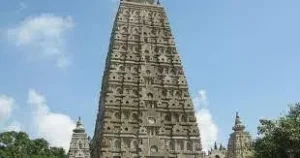
- Features:
-
- Grand Temple: A 50-meter-high structure with a pyramidal shikhara (tower) comprising several layers of niches, arch motifs, and fine engravings.
- Sacred Places: The complex includes six sacred places within an enclosed area and a seventh one, the Lotus Pond, just outside the enclosure to the south.
- Bodhi Tree: Located to the west of the main temple, believed to be a direct descendant of the original Bodhi Tree under which Buddha attained enlightenment.
- Vajrasana: Ashoka’s stone slab marking the exact position where Buddha sat, traditionally called the Buddha’s vajrasana (“diamond throne” or “thunder seat”).
- Four Towers: Identical to the central shikhara but smaller, each topped with an umbrella-like dome.
- Buddha Statue: A shrine inside the temple holds a yellow sandstone statue of the Buddha encased in glass.
- Complex Area: Covers 4.8 hectares (11.9 acres), including ancient shrines and modern structures built by Buddhist devotees.
-
Asur Community
- News: Asur language debate took place in Nepal as Jharkhand celebrated International Day of the World’s Indigenous Peoples.
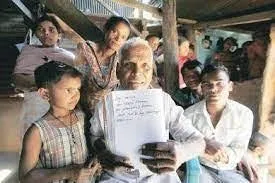
- Overview:
-
- The Asur is a small tribal community that resides in the forests of Palamu, Gumla, and Lohardaga in Jharkhand, and inhabits regions between Jharkhand and West Bengal.
- Their population is around 33,000.
-
- Ethnic Group:
-
- The Asur belong to the Astro-Asiatic ethnic group and have a rich oral tradition of literary value.
-
- Status:
-
- They belong to a particularly vulnerable tribal group (PVTG) in India.
-
- Endangered Language:
-
- The Asur language, which has no script of its own, was listed by UNESCO as a “definitely endangered language.”
-
- History
-
- Oral history mentions that Sarguja district in Madhya Pradesh was the original habitat of the Asurs or at least one of their three clans
-
- Traditional Occupation:
-
- Known as ancient metallurgists, the Asurs were traditional iron smelters. However, most have now taken up agriculture for their livelihood.
-
- Religion and Beliefs:
-
- Sarana Faith: Most Asurs follow the ‘Sarana’ (or Sharana) faith, which emphasizes ecology as the most important ethical guide for humans.
- The Sarana theology depicts that man and other animals belong to the earth, not the other way around.
- Mythology: The Asurs claim to be descendants of Mahishasur, the buffalo-demon whom Goddess Durga kills after a spirited fight lasting nine nights. Language.
-
- Asur Society:
-
- Clans: The Asur society is organized into 12 clans, each named after different animals, birds, and food grains.
- Family: Following the clans, family is the second-most prominent institution in Asur society.
- Community Council: Disputes are resolved through their own community council known as ‘jati panch.’
- Kinship Ties: The Asurs maintain putative kinship ties with neighboring tribes like Kharwar, Munda, and others.
- Public Spaces: Apart from burial sites, they share all other public spaces with their neighboring communities.
- Traditional Attire: Men wear dhotis as traditional clothing.
- Female Adornments: Women adorn tattoo marks depicting totemic objects on their bodies as ornaments.
- Marriage: Asurs follow monogamy as a general rule, but in cases of barrenness, widowhood, or widowerhood, they may practice bigamy or even polygamy.
- Endogamy: Marriage within the tribe (endogamy) is commonly practiced.
-
- International Day of the World’s Indigenous Peoples:
-
- In order to raise awareness of the needs of these population groups, every 9 August commemorates the International Day of the World’s Indigenous Peoples
- Theme 2024: “Indigenous Youth as Agents of Change for Self-determination.”
-
UPSC GS 2
Samvidhaan Hatya Diwas
- News: The Centre has declared June 25 as ‘Samvidhaan Hatya Diwas’.
- Purpose:
-
- The day commemorates the contributions of individuals who endured hardships during the Emergency period imposed on June 25, 1975.
- It honors those who resisted the abuse of power during that time.
-
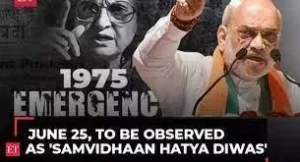
- Historical Context:
-
- On June 25, 1975, then Prime Minister Indira Gandhi imposed the Emergency in India.
- This led to widespread persecution, censorship, and suppression of media and civil liberties.
- The Union government declared June 25 as ‘Samvidhaan Hatya Diwas’ to mark this significant historical event.
-
Secret Service
- News: Former US President Donald Trump was shot at during an election rally. The shooter was then shot and killed by the Secret Service.
- Definition:
-
- The United States Secret Service was founded in 1865 and is one of the oldest federal investigative law enforcement agencies.
- Its initial mandate was to combat the counterfeiting of US currency.
-
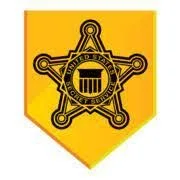
- Nodal Agency:
-
- The Secret Service is part of the Department of Homeland Security.
- Eligible candidates are identified by the Secretary of Homeland Security after consultation with an advisory committee.
-
- Aim:
-
- The Secret Service’s mission is to maintain the integrity of the democratic process and ensure the continuity of government.
-
- Protection Mandate: The Secret Service is mandated to protect several key individuals, including:
-
- The Vice President
- The President-Elect
- Their Immediate Families
- Former Presidents And Their Spouses (Except When The Spouse Remarries)
- Children Of Former Presidents Until Age 16
- Former Presidents, Such As Trump, Are Entitled To Lifelong Protection Unless They Refuse It.
- Major Presidential And Vice-Presidential Candidates And Their Spouses Within 120 Days Of A General Presidential Election.
-
- Protection Methods: The Secret Service’s protective methods include:
-
- Permission to carry firearms
- Authority to make arrests without warrants for any offense or felony under “reasonable grounds”
- The agency relies on meticulous advance work and threat assessments to identify potential risks to protectees.
- Their protective work begins long before their physical presence is required.
- The military further supports the Secret Service through its Explosive Ordnance Disposal teams and communications resources.
-
e-office Platform
- News: As part of its 100-day agenda, the Government of India has unveiled a plan to implement the e-office platform across subordinate offices, and autonomous bodies.
- Definition:
-
- The e-Office platform aims to streamline operations and enhance efficiency across 133 identified offices.
-
- Nodal Ministry:
-
- This initiative is led by the Ministry of Personnel, Public Grievances & Pensions, with the National Informatics Centre (NIC) serving as the knowledge partner for its implementation.
-

- Key Components:
-
- File Management System (e-File): It is a workflow-based system that enhances the features of the traditional manual handling of files with a more efficient electronic system.
- Knowledge Management System (KMS): It introduces the concept of a central repository of documents within an organization.
- It allows users to create and manage electronic documents within the workflow, providing version tracking, history, and easy search and view functionalities.
- Work from Anywhere (WAW) Portal: It serves as a gateway for a virtual office, enabling officials to securely access their office functions from any location
- . This portal acts as a one-stop solution for office functions.
- Smart Performance Appraisal Report Recording Online Window (SPARROW): It is a web-based application for processing the Annual Performance Appraisal Reports (APAR).
- Employees can fill in their APARs online, which are then reported and reviewed by the official hierarchy.
-
Read also: Explained India-Bangladesh Relations | UPSC
UPSC GS 3
Commemorative Coins
- News: The Centre is issuing a Rs 100 denomination commemorative coin on the occasion of the M Karunanidhi’s birth centenary.
- Definition:
-
- Commemorative or ceremonial coins are issued to commemorate a certain event, celebrate a certain person, or promote a specific message.
- These coins have a distinctive design that references the occasion for which they were issued and different, generally larger, denomination than regular coins.
- Commemorative coins are typically issued in very small quantities and kept by the Reserve Bank of India (RBI) as uncirculated collectors’ items.
- However, some commemorative coins are meant for mass circulation, depending on the Centre’s intention behind issuing a particular coin.
-
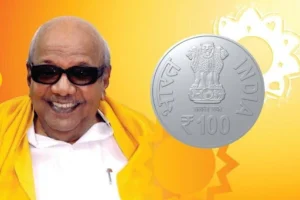
- Purpose:
-
- Since ancient times, coins have been used as tools to disseminate rulers’ messages and further their image, often quite literally.
- For instance, in 1974, the Indira Gandhi government introduced a coin with the theme and legend ‘Family Planning’, reflecting her government’s population control push.
-
- Tools of Remembrance:
-
- Commemorative coins are also used as tools of remembrance.
- The first commemorative coins in India were issued in 1964 after the death of Prime Minister Jawaharlal Nehru.
- Similarly, in 1969, the government launched a coin series celebrating Mahatma Gandhi’s birth centenary.
- Some coins commemorate institutions, such as the State Bank of India or the Mata Vaishno Devi Shrine Board, or occasions like the 75th anniversary of Indian Independence, rather than individuals.
-
- Issuing Authority:
-
- The sole authority to print or mint any Indian currency lies with the Reserve Bank of India, which operates under the Union Finance Ministry.
- Thus, it is the Union Finance Ministry that ultimately decides whether to issue a commemorative coin or not.
- However, state governments, government-run cultural institutions, or even private organizations can request the government to issue commemorative coins.
For instance, the request for Karunanidhi commemorative coins came from the Tamil Nadu government last year.
-
Rosewood Tree (Dalbergia Latifolia)
- News: Residents of Chumphon raised concerns over the unauthorised cutting of five large rosewood trees by a local community leader.
- Overview:
-
- ‘Rosewood’ is a commercial term encompassing a wide range of tropical hardwoods in the Fabaceae (Leguminosae) family.
- Rosewood trees are native to Brazil, Honduras, Jamaica, Africa, and India.
- Rosewood is a fast-growing nitrogen-fixing tree that can easily be propagated and will grow on any well-drained soil, even on pure sand.
-
- Indian rosewood Dalbergia Latifolia:
-
- Other Names: Indonesian rosewood, Bombay blackwood, Malabar rosewood, black rosewood and sitsal.
- Description:
- Indian Rosewood is an erect deciduous tree.
- These plants are native to India and thrive in tropical and subtropical regions.
- Distribution
- It is distributed in the sub-Himalayan tract of eastern Uttar Pradesh to Sikkim.
- It also occurs in central, western, and southern India.
-
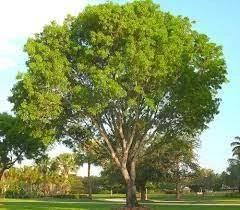
-
-
- Key Features:
- Indian Rosewood has delicate, light green, oval-pointed leaflets and can quickly reach 60 feet in height with a 40-foot spread.
- The white flowers are followed by slender, flat, brown, one to four-seeded pods.
- Habitat and Soil Requirements:
- Indian Rosewood thrives in a maximum temperature range of 38°C to 50°C and a minimum temperature range of 0°C to 15°C.
- The annual rainfall ranges from 750mm to 5000mm.
- It occurs in a variety of soils and geological formations but it attains best development in well-drained deep moist soils.
- Uses:
- Indian Rosewood is an important fuelwood and is also used for shade and shelter.
- Its wood is used for making furniture, doors, windows, shop floors, plywood, skis, musical instruments, carvings, etc.
- Because of its durability, Rosewood is often used in martial art weaponry, particularly as the shaft of spears and in gun staves.
-
Chromium
- News: The NGT has ordered the state government to supply safe drinking water to areas affected by chromium-contaminated groundwater.
- Overview:
-
- Chromium is a chemical element with the symbol Cr and atomic number 24.
-
- Occurrence:
-
- It is naturally found in rocks, animals, plants, soil, and volcanic dust and gases.
-
- Mining:
-
- Chromium is mined as chromite (FeCr2O4) ore.
-
- Distribution:
-
- Global: South Africa is the leading mine producer of chromium worldwide followed by Turkey and Kazakhstan.
- India: Chromite deposits of Sukinda and Nausahi ultramafic belt of Odisha constitutes 94% of the country’s chromite resources.
- Other states with chromite are Manipur, Nagaland, Karnataka, Jharkhand, Maharashtra, Tamil Nadu, Telangana and Andhra Pradesh
-
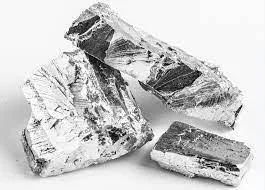
- Forms:
-
- Trivalent Chromium (Cr³⁺): Safe for humans.
- Hexavalent Chromium (Cr⁶⁺): Toxic to humans.
-
- Properties:
-
- Appearance: Chromium is a lustrous, brittle, hard metal. Its colour is silver-gray and it can be highly polished.
- Air Resistance: Chromium does not tarnish in air.
- Reaction with Heat: When heated, it burns and forms green chromic oxide.
- Classification: Classified as a transition metal, it is a solid at room temperature.
- Oxygen Instability: Chromium is unstable in oxygen, producing a thin oxide layer that protects the metal below by being impermeable to oxygen.
-
- Applications:
-
- Metallurgy: Enhances hardenability and resistance to corrosion and oxidation in iron, steel, and nonferrous alloys.
- Stainless Steel: Widely used to produce stainless steel and nonferrous alloys.
- Other Uses: Alloy steel, metal plating, pigments, leather processing, catalysts, surface treatments, and refractories.
-
Sarus Crane (Antigone Antigone)
- News: The latest summer census taken up for sarus crane sightings shows that their count has risen across Uttar Pradesh (UP).
- Sarus Crane:
-
- The Sarus crane is the tallest flying bird in the world standing 152-156 cm tall with a wingspan of 240cm.
-
- Characteristics:
-
- Adults: Light grey body plumage with a greenish skin crown. Head and upper neck covered in red skin. Ear area has greyish feathers. Legs are red.
- Juveniles: Cinnamon-brown feathers with a less obvious greyish ear patch.
- Breeding Season: Coincides with heavy rainfall during the monsoon.
- Mating Behavior: Known to mate for life with a single partner.
- Dietary Habits: Includes aquatic plants, invertebrates, grains, small vertebrates, and insects.
-
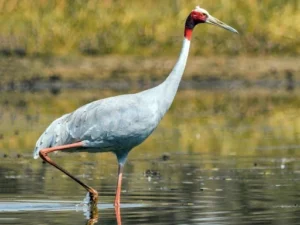
- Habitat and Distribution:
-
- Global Distribution: Three disjunct populations in the Indian subcontinent, Southeast Asia, and northern Australia.
- Indian Subcontinent: Found in northern and central India, Terai Nepal, and Pakistan.
- Habitat: Typically found wading in shallow wetlands or cropped agricultural areas.
-
- Conservation Status:
-
- IUCN Status: Vulnerable (VU)
- CITES Appendix: II
- CMS Listing: II
-
